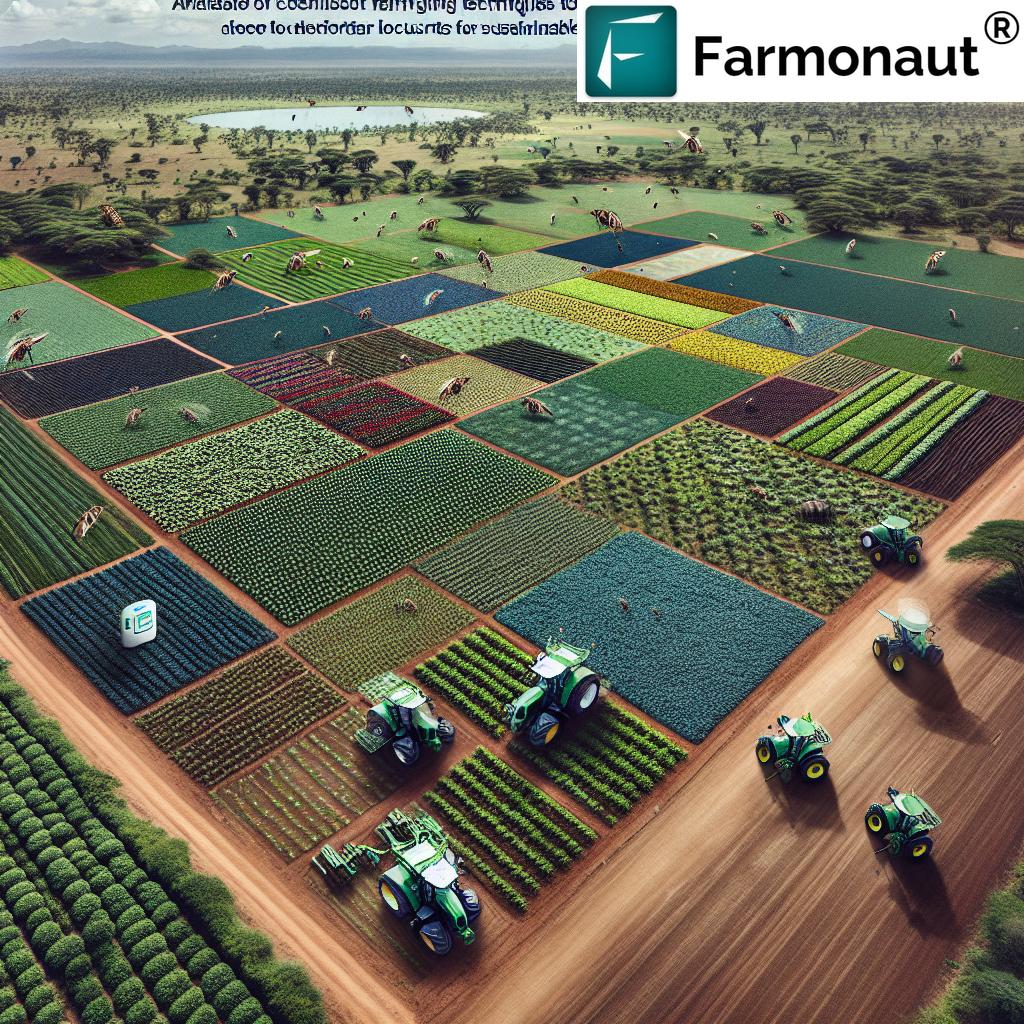East African Farmers: Innovative Locust Control Strategies for Crop Protection and Food Security
“East African locust swarms can consume crops equivalent to the daily food intake of 35,000 people in just 24 hours.”
In the vast arable lands of East Africa, farmers face an unprecedented crisis that threatens not only their livelihoods but also the food security of entire nations. Massive locust swarms have descended upon the region, devouring crops at an alarming rate and leaving devastation in their wake. This agricultural disaster demands immediate attention and innovative solutions to protect crops, livestock, and the economic stability of affected areas.
At Farmonaut, we understand the critical importance of addressing this pest management challenge head-on. Our team of agricultural experts and technologists has been closely monitoring the situation, leveraging our advanced satellite-based crop monitoring capabilities to provide real-time insights to farmers and policymakers alike. In this comprehensive blog post, we’ll explore the innovative locust control strategies being employed across East Africa, delve into the latest trends in pest management, and examine how precision agriculture technology is playing a pivotal role in combating this infestation.
The Locust Crisis: A Threat to Food Security
The current locust outbreak in East Africa is considered one of the worst in decades. Countries such as Kenya, Ethiopia, Somalia, and Uganda are grappling with swarms that can cover hundreds of square kilometers, with a single swarm capable of consuming as much food as 35,000 people in a day. This unprecedented scale of infestation poses a severe threat to food security, agricultural livelihoods, and economic stability in the region.
- Crop destruction: Locusts devour a wide range of crops, including maize, sorghum, wheat, and pasture grasses essential for livestock.
- Economic impact: The World Bank estimates that the locust crisis could cost East Africa and Yemen $8.5 billion in damages and lost production.
- Long-term consequences: Beyond immediate crop losses, the infestation can lead to long-term food shortages, increased poverty, and potential social unrest.
As we at Farmonaut continue to monitor the situation through our satellite-based crop health monitoring system, we’ve observed the urgent need for a multi-faceted approach to locust control. Let’s explore some of the innovative strategies being implemented across the region.
Innovative Locust Control Strategies
East African farmers, in collaboration with government agencies and international organizations, are employing a range of innovative techniques to combat the locust threat. These strategies combine traditional methods with cutting-edge technology to maximize effectiveness and minimize environmental impact.
1. Precision Agriculture and Real-Time Monitoring
At the forefront of modern locust control is the use of precision agriculture technology. Satellite imagery and remote sensing play a crucial role in early detection and monitoring of locust swarms. Our Farmonaut platform utilizes advanced algorithms to analyze multispectral satellite data, providing farmers and agricultural authorities with real-time information on:
- Vegetation health indices (NDVI) to identify areas of crop stress
- Soil moisture levels to predict potential breeding grounds
- Swarm movement patterns for targeted control efforts
By leveraging this technology, farmers can implement targeted control measures more efficiently, reducing the overall use of pesticides and minimizing environmental impact.

2. Aerial Crop Spraying Techniques
Aerial spraying remains one of the most effective methods for controlling large locust swarms. However, innovative approaches are being implemented to enhance its efficiency and reduce environmental impact:
- Precision spraying: GPS-guided drones and aircraft ensure accurate pesticide application, minimizing overspray and reducing chemical usage.
- Biopesticides: The use of naturally derived pesticides, such as fungal-based products, offers a more environmentally friendly alternative to traditional chemical sprays.
- Targeted timing: Spraying operations are coordinated with locust behavior patterns, focusing on periods when the insects are most vulnerable.
“Aerial crop spraying for locust control can cover up to 2,000 hectares of farmland in a single day.”
3. Sustainable Farming Practices
While immediate control measures are crucial, long-term strategies focus on building resilience in agricultural systems. Sustainable farming practices play a vital role in mitigating the impact of locust infestations:
- Crop diversification: Planting a variety of crops reduces the risk of total loss and can deter locust feeding.
- Intercropping: Growing multiple crops in the same field can create natural barriers to locust movement.
- Conservation agriculture: Techniques such as minimal tillage and crop rotation help maintain soil health and natural pest predators.
Our Farmonaut platform supports these practices by providing farmers with data-driven insights on crop health and soil conditions, enabling them to make informed decisions about planting strategies and resource allocation.
4. Early Warning Systems and Community Engagement
Effective locust control relies heavily on early detection and rapid response. Innovative early warning systems are being developed and implemented across East Africa:
- Mobile apps: Farmers can report locust sightings and receive alerts through smartphone applications.
- Crowdsourced data: Community-based monitoring networks provide real-time information on locust movements.
- Predictive modeling: Advanced algorithms analyze weather patterns and historical data to forecast potential outbreaks.
These systems, combined with community engagement and education programs, empower farmers to take proactive measures in protecting their crops.
The Role of Technology in Locust Control
As we at Farmonaut continue to develop and refine our precision agriculture solutions, we recognize the critical role that technology plays in addressing the locust crisis. Here are some key technological innovations making a significant impact:
1. Satellite-Based Monitoring
Our satellite-based crop health monitoring system provides invaluable data for locust control efforts:
- High-resolution imagery: Detailed views of affected areas guide targeted intervention strategies.
- Multispectral analysis: Advanced sensors detect subtle changes in vegetation health, indicating potential locust activity.
- Time-series data: Historical imagery helps track the progression of infestations and evaluate control measures.
Explore our satellite-based monitoring capabilities: Farmonaut Web App
2. Artificial Intelligence and Machine Learning
AI-powered systems are revolutionizing locust control strategies:
- Swarm prediction: Machine learning algorithms analyze environmental data to forecast locust breeding and movement patterns.
- Image recognition: AI-enhanced drones can identify and track locust swarms with high accuracy.
- Optimized resource allocation: Intelligent systems help prioritize control efforts based on real-time data and predictive modeling.
3. IoT and Sensor Networks
Internet of Things (IoT) devices and sensor networks provide granular data on environmental conditions:
- Weather stations: Localized climate data informs pest management decisions.
- Soil sensors: Real-time soil moisture and temperature readings help identify potential breeding grounds.
- Pheromone traps: Connected traps provide early warning of locust presence in an area.
Access real-time agricultural data through our API: Farmonaut API
Collaborative Efforts and International Response
Addressing the locust crisis requires coordinated action at local, national, and international levels. Several key initiatives are underway:
- FAO Locust Watch: The UN Food and Agriculture Organization provides regular updates and coordinates control efforts across affected countries.
- Regional cooperation: East African nations are sharing resources and expertise to combat the transboundary threat.
- Research partnerships: International collaborations are driving innovation in locust control methods and technologies.
At Farmonaut, we’re committed to supporting these efforts by providing our advanced crop monitoring and data analysis capabilities to researchers, policymakers, and farmers alike.

Challenges and Future Outlook
While significant progress has been made in developing innovative locust control strategies, several challenges remain:
- Climate change: Shifting weather patterns may lead to more frequent and severe locust outbreaks.
- Resource constraints: Many affected countries struggle with limited financial and technical resources for pest control.
- Environmental concerns: Balancing effective control measures with ecological preservation remains an ongoing challenge.
Looking ahead, the future of locust control in East Africa will likely involve:
- Increased integration of technology and traditional control methods
- Greater emphasis on predictive modeling and early intervention
- Development of more environmentally friendly pest management solutions
- Enhanced regional cooperation and knowledge sharing
Farmonaut’s Commitment to Agricultural Innovation
As a leading provider of precision agriculture technology, Farmonaut is dedicated to supporting East African farmers in their fight against locust infestations. Our suite of tools and services offers valuable insights for effective pest management:
- Real-time crop health monitoring
- AI-powered advisory systems
- Resource management tools
- Data-driven decision support
Experience the power of precision agriculture: Download Farmonaut Android App | Download Farmonaut iOS App
Locust Control Strategies Comparison
| Control Strategy | Technology/Equipment Used | Effectiveness Rating (1-5) | Environmental Impact | Implementation Cost ($/hectare) | Adoption Rate (%) |
|---|---|---|---|---|---|
| Aerial crop spraying | GPS-guided aircraft, biopesticides | 5 | Medium | 50-100 | 80% |
| Precision agriculture monitoring | Satellite imagery, AI algorithms | 4 | Low | 10-30 | 60% |
| Biological control methods | Natural predators, fungal agents | 3 | Low | 20-40 | 40% |
| Early warning systems | Mobile apps, sensor networks | 4 | Low | 5-15 | 70% |
| Community-based control efforts | Manual removal, traditional methods | 2 | Low | 1-5 | 90% |
Conclusion: A Call to Action
The locust crisis in East Africa presents a formidable challenge to farmers, policymakers, and technologists alike. However, through innovative control strategies, advanced technology, and collaborative efforts, we are making significant strides in protecting crops and ensuring food security for millions.
As we continue to develop and refine our precision agriculture solutions at Farmonaut, we remain committed to supporting East African farmers in their fight against locust infestations. By leveraging satellite technology, AI-driven insights, and real-time monitoring, we empower farmers to make informed decisions and implement effective pest management strategies.
The battle against locusts is far from over, but with continued innovation, cooperation, and determination, we can mitigate their impact and build more resilient agricultural systems for the future.
FAQs
- Q: How do locusts impact food security in East Africa?
A: Locusts can consume vast amounts of vegetation, destroying crops and pastures. This leads to immediate food shortages and long-term economic impacts on farming communities. - Q: What role does satellite technology play in locust control?
A: Satellite technology provides real-time monitoring of crop health, soil conditions, and locust movements, enabling targeted and efficient control measures. - Q: Are there environmentally friendly methods for locust control?
A: Yes, methods such as biopesticides, biological control using natural predators, and sustainable farming practices offer more eco-friendly alternatives to traditional chemical spraying. - Q: How can individual farmers contribute to locust control efforts?
A: Farmers can participate in early warning systems, implement sustainable farming practices, and cooperate with local authorities in coordinated control efforts. - Q: What is the future outlook for locust control in East Africa?
A: The future involves increased use of technology, predictive modeling, and regional cooperation, along with a focus on developing more sustainable and environmentally friendly control methods.
Explore Farmonaut’s precision agriculture solutions:
For developers: API Developer Docs
Farmonaut Subscriptions






